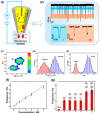Nanopipettes as a Potential Diagnostic Tool for Selective Nanopore Detection of Biomolecules
- PMID: 39727892
- PMCID: PMC11674911
- DOI: 10.3390/bios14120627
Nanopipettes as a Potential Diagnostic Tool for Selective Nanopore Detection of Biomolecules
Abstract
Nanopipettes, as a class of solid-state nanopores, have evolved into universal tools in biomedicine for the detection of biomarkers and different biological analytes. Nanopipette-based methods combine high sensitivity, selectivity, single-molecule resolution, and multifunctionality. The features have significantly expanded interest in their applications for the biomolecular detection, imaging, and molecular diagnostics of real samples. Moreover, the ease of manufacturing nanopipettes, coupled with their compatibility with fluorescence and electrochemical methods, makes them ideal for portable point-of-care diagnostic devices. This review summarized the latest progress in nanopipette-based nanopore technology for the detection of biomarkers, DNA, RNA, proteins, and peptides, in particular β-amyloid or α-synuclein, emphasizing the impact of technology on molecular diagnostics. By addressing key challenges in single-molecule detection and expanding applications in diverse biological areas, nanopipettes are poised to play a transformative role in the future of personalized medicine.
Keywords: molecular diagnostics; nanopipette; nanopore; single molecule; solid-state nanopore.
Conflict of interest statement
The authors declare no conflicts of interest.
Figures

















Similar articles
-
Nanopore-Based Neurotransmitter Detection: Advances, Challenges, and Future Perspectives.ACS Nano. 2025 Jul 15;19(27):24404-24424. doi: 10.1021/acsnano.5c04662. Epub 2025 Jun 29. ACS Nano. 2025. PMID: 40583472 Free PMC article. Review.
-
Aerolysin Nanopore Electrochemistry.Acc Chem Res. 2025 Feb 18;58(4):517-528. doi: 10.1021/acs.accounts.4c00630. Epub 2025 Jan 28. Acc Chem Res. 2025. PMID: 39874057 Review.
-
Recent progress in electrochemical assessment of DNA based on nanostructured sensors.Biomed Microdevices. 2025 Jul 12;27(3):36. doi: 10.1007/s10544-025-00763-0. Biomed Microdevices. 2025. PMID: 40650825 Free PMC article. Review.
-
An expanded method for malaria parasite genetic surveillance using targeted nanopore sequencing.Gates Open Res. 2025 Jul 24;9:49. doi: 10.12688/gatesopenres.16355.1. eCollection 2025. Gates Open Res. 2025. PMID: 40718588 Free PMC article.
-
Rapid molecular tests for tuberculosis and tuberculosis drug resistance: a qualitative evidence synthesis of recipient and provider views.Cochrane Database Syst Rev. 2022 Apr 26;4(4):CD014877. doi: 10.1002/14651858.CD014877.pub2. Cochrane Database Syst Rev. 2022. PMID: 35470432 Free PMC article.
Cited by
-
Nanopore-Based Neurotransmitter Detection: Advances, Challenges, and Future Perspectives.ACS Nano. 2025 Jul 15;19(27):24404-24424. doi: 10.1021/acsnano.5c04662. Epub 2025 Jun 29. ACS Nano. 2025. PMID: 40583472 Free PMC article. Review.
References
-
- Ohshiro T. Nanodevices for Biological and Medical Applications: Development of Single-Molecule Electrical Measurement Method. Appl. Sci. 2022;12:1539. doi: 10.3390/app12031539. - DOI
Publication types
MeSH terms
Substances
Grants and funding
LinkOut - more resources
Full Text Sources

